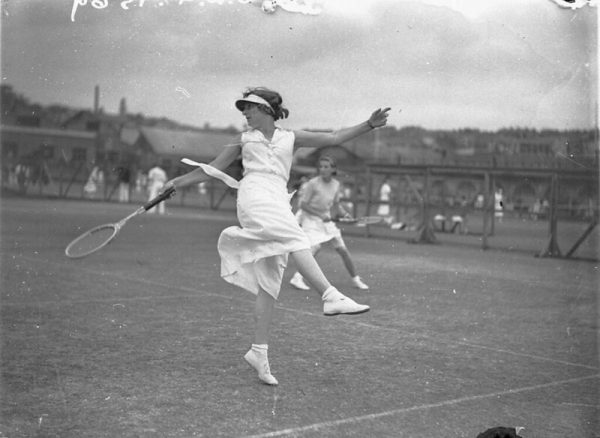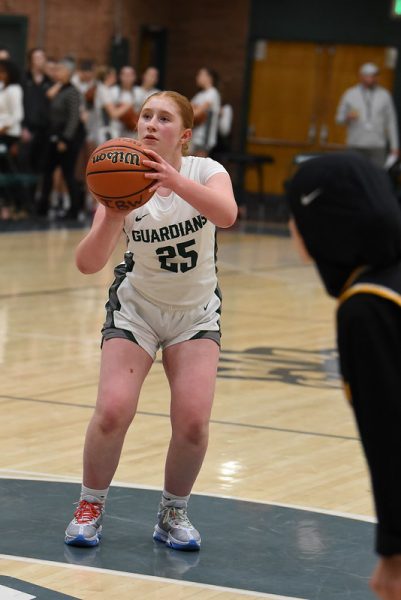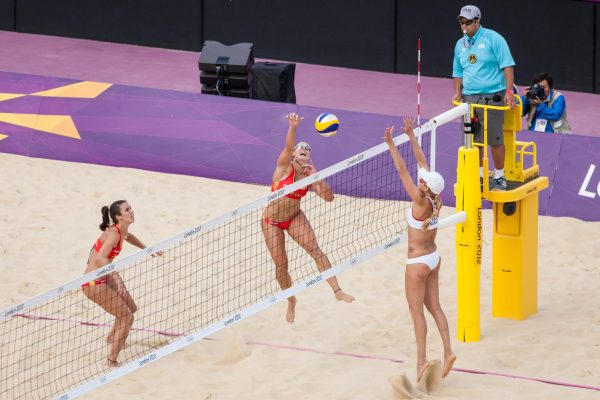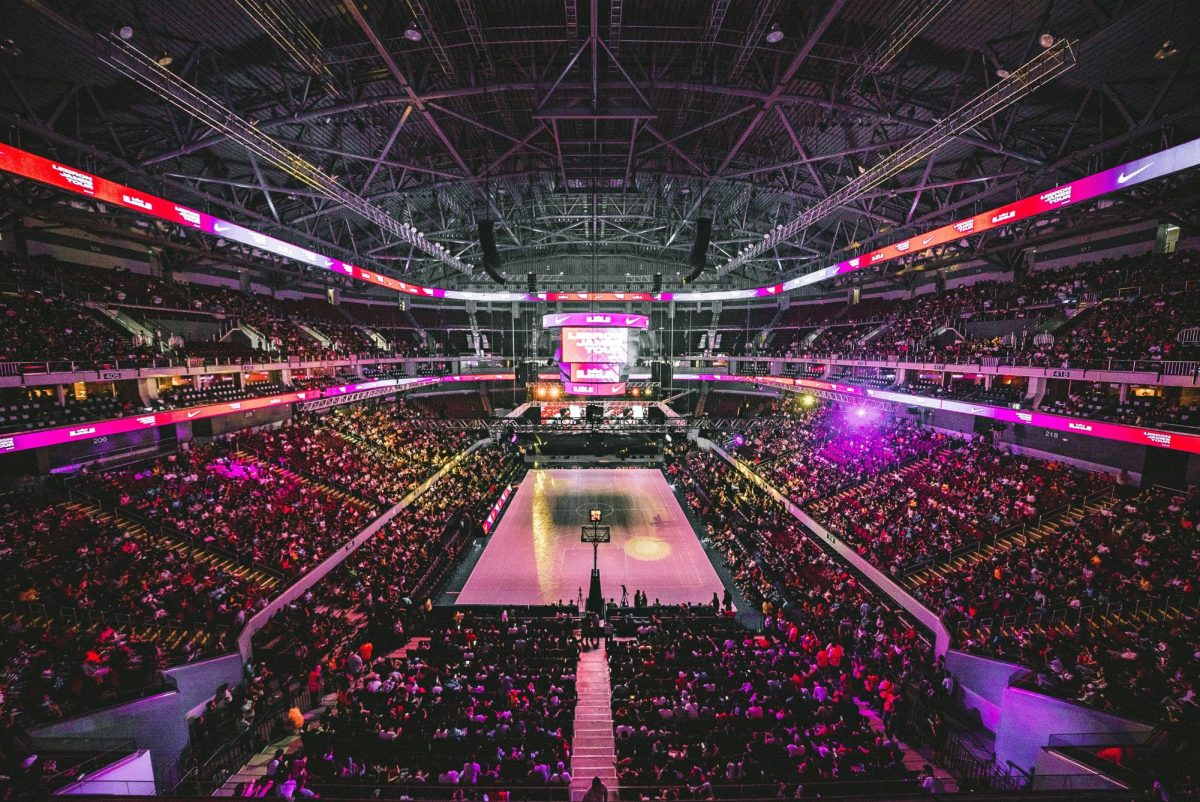According to Women in Sport, 78 percent of girls avoid participating in sports while on their period.
78 percent.
CEO of Women in Sport, Stephanie Hillborne said, “Our research has found that 59% of teenage girls who used to be sporty [play sports] like competitive sport[s], but they’re being failed due to early years stereotyping, inadequate opportunities, and a complete dearth [lack] of knowledge about managing female puberty.” These aspects are reflected in women’s uniforms, particularly the stereotyping and dysfunctionality of the uniforms for female bodies.
Women were first allowed to compete in the Olympic Games starting in 1900. They were only allowed to compete in five of 20 sports; whereas men competed in all. These five sports consisted of tennis, sailing, croquet, golf and horseback riding, all seen as “compatible with their femininity and fragility,” according to the Encyclopedia of European History.
Many men were dismissive of female athletes because they saw them as distracting, leading many men to oppose women participating in the Olympics in the first place. When they were finally allowed to take part, they had to follow strict regulations regarding their uniforms. The main problem with their uniforms was that they were not made to fit the needs of an athlete. Where men could wear shorts and t-shirts, women were expected to wear long, corseted dresses, boots, and hats, as part of a “decency code” they were instructed to follow.

In the early 20th century, the functionality of women’s uniforms became more important. Suzanne Legen, a tennis player in the 1920s, started to remove her hat and wear shorter skirts made of more practical materials. A few decades later, female uniforms shifted to practicality over decency, as women started wearing more comfortable materials.
In the 1980s and 90s, women’s uniforms became ‘sexier,’ seemingly embracing the indecency that was once feared. Emphasizing curves and body shapes, uniforms quickly became more about aesthetics than comfort. Today, most uniform styles are more practical, however, some still prioritize aesthetics over comfort — and many female athletes face backlash if they choose to wear something they prefer instead of the recommended uniform.
In 2018, Serena Williams wore a black bodysuit at the French Open rather than the recommended skirt, shorts, or collared shirt. Her outfit was criticized by tennis officials and was ultimately prohibited because it was “unacceptable” for her sport. Female athletes around the world have continued to push for practicality and functionality in their uniforms.
During the spring and summer of 2023, one response to the dysfunctionality of women’s uniforms was a worldwide movement of professional women’s soccer teams, banning white shorts. This movement is motivated by the need for women’s uniforms to be responsive and recognize, specifically the female experience of periods.
In April 2023, the women’s national team of New Zealand, the Ford Football Ferns, released new uniforms for the 2023 season. Most prominently, their home uniform no longer features white shorts. However, the team kept the white home uniform tradition with a white jersey and white socks. The change in the uniform aims to avoid “period anxiety,” or concerns over leaking through uniforms. This change was met with high support from players and staff as it allows players to perform without any worries.
Other soccer teams like Orlando Pride and England’s national women’s soccer team have also shifted away from using white shorts. Ireland’s women’s rugby team has followed the soccer teams’ example, as well as many other women’s sports teams. In addition to this shift, corporations, such as Nike, are working to create women’s uniforms that meet their needs. In addition to New Zealand releasing the new 2023 uniforms, Nike also announced that the new uniform kits for the nations they represent will include technology in their clothing that prevents period leaks.
Inspired by this movement, Ida B. Wells sophomores Ainsley Porter, Zorina Johnson, and Jane Coffey-Read have taken action toward creating the same change in PIL athletics. The three have goals of making women’s sports an open space for all, with no barriers that stop women from continuing or joining. “I was interested in getting into the space of making women’s sports more [welcoming], cause it’s becoming more popular nowadays, so getting into the space or position of being able to help it become something more than it is right now,” said Coffey-Read.

“Uniforms are one of the biggest reasons why women drop out of sports, and a big part of that is being uncomfortable. I think, hopefully, it will open doors for other girls and women at our school, so they feel more comfortable,” said Porter on the effects of banning white shorts. “I just want to make sports safer for girls and women.”

“I think a lot more girls would be comfortable participating in sports at our school,” said Johnson. “I don’t think that [players] should have to wear such short shorts.”
This issue with white bottoms is not only felt by soccer players. Basketball players, softball players, and others feel this same sentiment. “For softball [pants], you can see right through it. We wear these sliding ‘sliding shorts’ and they are yellow or purple, [so] you can see it,” Sam Stevens, a sophomore and softball player at Ida B. Wells said. “There is a point where you can make pants that aren’t see-through. Why did we have to get the see-through pants?” There are also unnecessary aspects of uniforms, often with roots of sexism. “There are definitely still some stereotypes [shown in the uniforms]. Like the v-cuts [in the jerseys],” said Stevens.

The issues with female uniforms extend beyond white bottoms. Many uniforms are impractical and dysfunctional or unnecessarily sexual. “The biggest issue right now is that they are not based off of what women should wear. They just copied and pasted what a man would wear for a meet and made it more feminine, which is not fair because there are a lot of differences in women’s bodies and men’s bodies,” said Coffey-Read. “Not just shorts are an issue, there have been issues found with [women’s] cleats, where they [cleats] are causing injury.”
Additionally, during a European tournament in 2021, a group of Norwegian handball players were fined for wearing shorts during a game. Olympic handball uniforms are some of the most revealing, at least for women. While men are allowed to wear shorts and tank tops, women need to wear bikini bottoms and tops. According to the International Handball Federation, players must wear bottoms “with a close fit and cut on an upward angle toward the top of the leg, and a maximum side width of 4 inches.” Men don’t have to wear bottoms like this.

Lene Westgaard-Halle, a member of the Norwegian Parliament posted on X “Dear @ihf_info, Can you please stop the forced bikini nonsense at your beach handball games? It is embarrassing, disgraceful, and sexist. You are ruining both the sport and your reputation.” The Norwegian Handball President Kåre Geir Lio followed up on this, calling the uniform regulations ‘embarrassing.’ “It’s not [appropriate clothing for] the activity when they are playing in the sand,” said Lio. Despite this, the team was fined nearly $1,700 for “improper clothing.”
During the 2021 Tokyo Olympics, a German gymnastics team protested their uniforms by wearing a full-length unitard. “We want to feel amazing, we want to show everyone that we look amazing,” said Sarah Voss, a 21-year-old German gymnast.
In addition to these problems, there are also concerns over the inclusivity of female uniforms. In many religious groups, modesty is essential. Due to some uniform regulations, some women aren’t able to participate in a lot of sports. “There’s a lot of Muslim girls that I know, who used to not be able to wrestle, because of the uniform, and [so] they went and changed that law. [One of my friends] now is a college wrestler, and she wrestles in a full-body suit, and her hijab,” said Johnson.
Issues of inclusivity have been met and challenged by ballet dancers of color as well. The uniforms are intended to be an extension of the dancer’s lines, and therefore, grace. Pointe shoes, often a pale, peachy-pink color, create a big issue for dancers of color. Many use the practice of “pancaking,” where they paint foundation onto their shoes to match their skin color. This is impractical and unsustainable since dancers have to replace their shoes anywhere from every day to every couple of weeks. Dancers of color have taken action to combat this issue. The UK company, Freed, responded to the ballerina’s calls with the first pointe shoes in the UK that match the skin tones of people of color, but this action has not been taken widely.
There are many challenges that female athletes will be met with, including their uniforms. However, as women’s sports continue and grow, players won’t back down to the issues they encounter. “I think we’ve come a very long way [with] women’s uniforms, that doesn’t mean we’re stopping now,” said Porter. “You see a lot of inequalities, still, but I think that we have to keep pushing for more equity and equality in sports, and that starts with uniforms.”
















